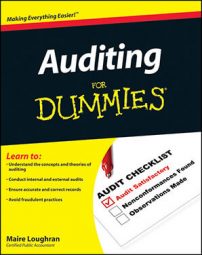During your audit of stockholder equity, you want to make sure your client’s dividends are correct. Making money is the whole reason that investors purchase stock, and dividends are one way that investors receive income from their investments. The two most common forms are cash and stock:
Cash dividends: Shareholders of record receive money in the form of a cash or electronic transfer based on how many shares of stock they own. A company can’t pay cash dividends unless it has positive retained earnings.
Stock dividends: Issuing stock dividends operates the same as issuing cash dividends: Each shareholder of record gets a certain number of extra shares of stock based on how many shares he already owns.
This type of dividend is expressed as a percentage rather than a dollar amount.
Corporations issue stock dividends when they’re low in operating cash but still want to throw the investors a bone to keep them happy. Keep in mind that dividends are not an expense of doing business. Dividend transactions appear on the balance sheet only, serving to reduce both cash (in the case of cash dividends) and retained earnings.
Be aware that your audit client could issue a liquidating dividend, which comes from paid-in capital and not retained earnings. The corporation is refunding the stockholder’s investment rather than paying income. A company can also issue a property dividend, which means a company asset (like a car) goes to the shareholder instead of cash. Discuss either event with your audit team leader.
In most cases, you don’t sample dividend transactions; you conduct a 100-percent audit. Here are some of the audit techniques to use:
Check out the meeting minutes of the board of directors to verify that the dividend was authorized.
Make sure the dividend amount and the date it’s paid reconcile with the meeting minutes. Check out the next section for more about the three dividend dates.
If your audit client uses an outside agent to process cash dividends, use a confirmation to verify the dividend transaction. Also, because the client has to make a payment to the dividend-disbursing agent before it can process the dividend payments, you can check the transaction by reconciling this payment to the total you get when you multiply the dividend declared by the number of shares outstanding.
The company’s board of directors is in charge of deciding when and how much of a dividend to issue. However, unless the corporation is closely held, board members can’t just wake up one morning and decide that today’s the day to distribute some cash! The dividend cycle consists of three events:
Declaring the dividend: This is the date the board of directors authorizes the dividend. After a dividend is declared, the company has a legal responsibility to pay it.
Recording the dividend: This date determines who receives the dividend, which consists of all shareholders of record.
Paying the dividend: Paying cash dividends reduces cash and dividends payable.
In its simplest form, issuing a stock dividend decreases retained earnings and increases common stock. Per generally accepted accounting practices, if the stock dividend is less than 20 to 25 percent of the number of the common stock shares outstanding, the company uses the stock’s fair market value, which is what the stock will trade for if sold in the open marketplace, for the transaction rather than its par value.

